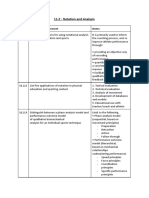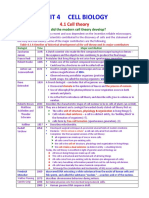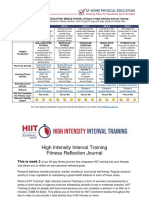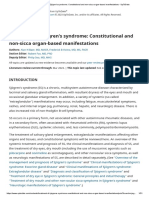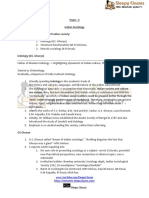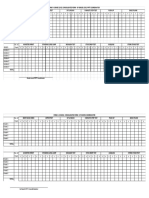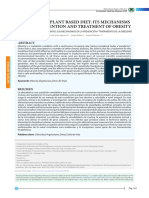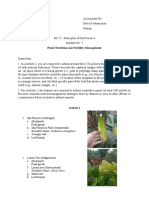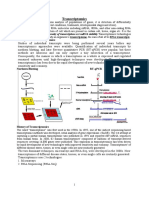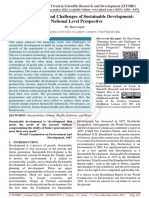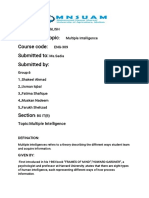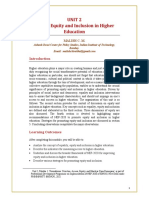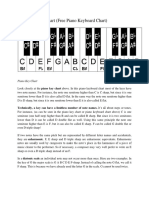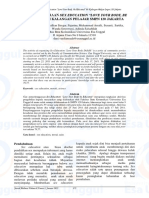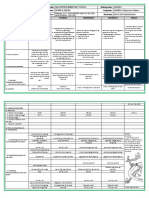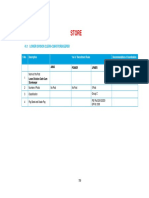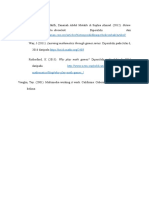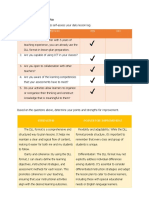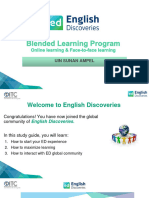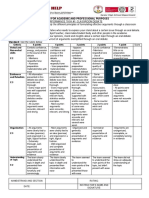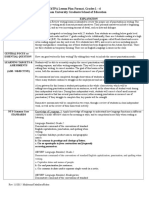UNIT 5
Holistic and Multidisciplinary Education,
and Multiple Entry-Exit
SUDHANSHU BHUSHAN
Head, Department of Higher and Professional Education,
National Institute of Educational Planning & Administration, New Delhi.
Email: sudhanshu@niepa.ac.in
Introduction
‘Holistic and Multidisciplinary Education’ is the central recommendation of the
National Education Policy-2020. It is said to be the architecture of 21st century
knowledge economy with a focus on problem solving approach. At first sight, it
may appear to be a simple proposition. A deeper analysis shows that
multidisciplinary education as a concept and process is more complex than it
looks. The purpose of this unit is to discuss the multidisciplinary education at an
introductory level and motivate teachers to probe further and pave the way for
multidisciplinary teaching and research in higher education institutions. Another
recommendation of NEP-2020 is the introduction of multiple entry-exit in Indian
higher education institutions through a flexible and innovative curricular structure
with a view to allow learners to get certification at yearly interval and possibly
create the scope for joining job market. The system will reduce the drop out and
increase the internal efficiency of higher education, besides creating the
possibility of life long education. This unit also examines the concept of multiple
entry-exit and throws up some issues and challenges associated with it.
Learning Outcomes
After going through this unit, higher education teachers should be able to:
Explain the concept of holistic and multidisciplinary education.
Differentiate multidisciplinary education from interdisciplinary education.
Describe the practices for moving towards interdisciplinarity.
Describe multiple entry-exit in higher education system, and underline the
challenges in its implementation.1
1
Unit 5, Module 2: 'Curriculum, Teaching-Learning and Assessment', is part of Professional Development
Programme on Implementation of NEP-2020 of IGNOU, New Delhi under PMMMNMTT. ©IGNOU, 2022
1
�NEP: Holistic, Multidisciplinary and Liberal Education
The National Education Policy 2020 proposes a “More Holistic and
Multidisciplinary Education”. It refers to ancient education in India which
provides for comprehensive understanding of all fields of knowledge from social
sciences, physical sciences, humanities, vocational and professional education.
NEP-2020 claims that all branches of knowledge are considered ‘arts’, which
modern education signifies it in terms of ‘liberal arts’. There is a call to return to
holistic and multidisciplinary education in the above sense. The rationale to a
holistic and multidisciplinary education is given in terms of increasing the
creativity, critical thinking, problem solving abilities, and developing capacities
of human beings – intellectual, aesthetic, social, physical, emotional, and moral.
NEP-2020 in Section 11 refers to holistic education, multidisciplinary education
and liberal education synonymously. Holistic is multidisciplinary, and
multidisciplinary is holistic, and furthermore holistic and multidisciplinary is
liberal education. Moreover, two different times in history, ancient and modern
(21st century), are compared without making distinction of the qualitative
differences of two time periods in the evolution of knowledge. This raises few
questions: (a) In what way knowledge is arts? (b) How knowledge of all arts lead
to holistic education? (c) What does it mean to return to ancient education? (d)
Does policy advocate the end to disciplinary basis of specialized knowledge
which is still preferred in universities worldwide? (e) Whether policy advocates
the move to less theory orientation or more practical orientation or a mix of both.
The interpretations of various terms vary in the academic circles and need to be
debated to have a clear grasp of holistic, multidisciplinary and liberal, and
interconnections between them. For the sake of clarity, notwithstanding the
differences in the academic community, I offer my own reading of the three terms
– holistic, liberal, and multidisciplinary education to the readers who may, in turn,
further discusses on the meaning of terms.
Holistic Education
Holistic education refers to the development of physical, emotional and cognitive
capacities. It refers to all round development of personality. It is a more
philosophical notion. Normatively speaking, it means what ought to be the
conception of good life. Education is valuable in intrinsic terms. However, it also
has an instrumental value to realize the good life. In a democratic country, holistic
education refers to the citizenship values. It refers to tolerance, secular values,
and inclusion as an important value. The purpose of all education, whether
disciplinary or multi-disciplinary, is holistic education. Hence, holistic does not
necessarily mean multidisciplinary.
Liberal Education
2
�Liberal education is scientific pursuit of knowledge. It develops questioning and
critical faculty of mind. Knowledge advances when, in the course of progress, the
existing knowledge is questioned and, in the process, an alternative hypothesis is
presented and examined. New knowledge is established with the questioning of
old knowledge. Liberal education does offer the choice to students to follow the
pursuit of knowledge through the choice of a particular discipline. However,
students may be offered the opportunity to explore before the choice of a
particular discipline is made final by them. For example, an undergraduate liberal
education in US allows to explore in early semesters to choose any subjects of
choice before a specialized discipline is selected. The close to this in Indian
higher education is the choice of core and electives, major or minor. How does
liberal education help achieve holistic education? In my opinion, it is by creating
the power of reason that an individual can decide what is good life that he/she
values. It means that liberal education may achieve holistic education in
particular ways for each and every individual. There cannot be a yardstick of
holistic that can be imposed from above. If the criterion of liberal education is
reason, then it may happen in both forms of education – disciplinary as well as
multidisciplinary.
Multidisciplinary Education:
The conjointment of various disciplines is multidisciplinary education. The term
is used in generic sense to denote that knowledge streams from various
disciplines can sometimes give better insight to understand social, economic and
natural phenomenon. The interaction of various disciplines can happen in various
ways – simple and complex. The understanding of such interaction is essential to
understand the variable ways of knowledge construction. At the turn of the 20th
century, the basic disciplines were limited to, say, Physics, Chemistry, Biology,
Mathematics, Economics, Sociology, Political Science, Geography, Psychology,
Language and Philosophy. Later, various applied branches of knowledge were
introduced, such as Engineering, Law, Medicine, etc. Gradually,
multidisciplinarity was introduced in teaching even basic disciplines. For
example, the teaching of Economics to an undergraduate also required teaching of
Mathematics and Statistics. With the conjointment of Economics with
Mathematics and Statistics, Economics flourished as it allowed Economics to
grow as empirical science and allowed modelling in estimation and forecasting
with greater precision. Mathematics and Statistics were of instrumental purpose to
develop Economics.
Various subject teachers of higher education institutions may find examples of
how their own disciplines advanced with the conjointment of other disciplines. In
this simple form, multidisciplinarity grew in the 20th century and syllabuses even
within a discipline were conceptualized in different universities all over the
world. In many instances, the growth of a new discipline was the result of
multidisciplinary education. For example, Management as a discipline grew with
the conjointment of Management with Economics, Finance, Commerce,
3
�Accounting, Psychology, Mathematics. Multidisciplinarity is evident in a syllabus
in UG programme on Environment Science. There is a conjointment of Physics,
Chemistry, Ecology, Bio-technology, Bio-Geography, Economics. In these
examples, we find that the growth of new multidisciplinary disciplines is the
result of interactions of disciplines as well multidisciplinary disciplines.
Therefore, multidisciplinary education which is referred to in NEP-2020 has been
a practice which evolved in various ways in syllabuses in the universities with the
growing specialization and in an effort to apply knowledge to solve the problems.
To sum up, we need to make an analytical distinction between holistic, liberal,
and multidisciplinary education mentioned in the NEP-2020. Holistic education is
a normative idea. Holistic implies empowering people. It must provide freedom to
choose life as an individual likes to lead, free from coercion. Holistic also means
the citizenship values, dignity and treating all individuals equal. The aim of all
education – disciplinary as well as multidisciplinary education - is to lead a
holistic life. Liberal education is based on scientific enquiry. Scientific progress
takes place through questioning, presenting an alternative hypothesis and testing.
Liberal education helps to develop critical mind and capacity to reason. Liberal
education began with the disciplinary basis of knowledge till the first quarter of
20th century and afterwards with the disciplinary and multidisciplinary education.
In spite of liberal education leading to the power of reason, liberal education may
be in conflict with holistic education, as it may lose touch with humanities.
Generally, liberal education should question prevailing faith and the reasoned
scrutiny should lead to justice in the society. Multidisciplinary education happens
with the conjointment of disciplines. Attempts to find solution to problems which
cannot be fully understood within a boundary of specific disciplines led to the
multidisciplinary education already in 20th century in various forms. No doubt,
multidisciplinary education opens new horizons of knowledge. However, there is
no guarantee that new horizons of knowledge will be also for holistic education
which cares for humanities. After having made the distinctions between holistic,
liberal, and multidisciplinary, which is sometimes confounded to be the same, it is
important to understand more closely multidisciplinary education which is further
confounded with interdisciplinary and transdisciplinary education. There are other
terms such as intradisciplinary and cross disciplinary. However, I shall
concentrate on the distinctions between multidisciplinary, interdisciplinary and
transdisciplinary education.
Multidisciplinary, Interdisciplinary and
Transdisciplinary Education
Multidisciplinary
Multidisciplinary education is the conjointment of disciplines without any
integration or synthesis of knowledge from various disciplines. Two or three
disciplines come together with ideas and methods from respective disciplines
which could be useful to understand a problem under consideration. For example,
Economics and Statistics are useful as they help to apply economic theory for
4
�empirical testing for which statistical tools are useful. No new knowledge is
created. To take another example, students of Management are taught Economics
as well as Statistics. Management of a firm is concerned with profit maximization
principle derived from Economics, and Statistics helps in market survey research.
In this example, Economics and Statistics have instrumental role in Management.
The syllabus of Management is an example of multidisciplinary education. The
Department of Management hires subject experts of Economics and Statistics in
the department or hires from outside the department to teach. Multiple examples
can be constructed by the subject experts of different departments.
Multidisciplinary in this simple form exists in various departments in teaching.
Interdisciplinary
The meaning as well as the process of interdisciplinary education is complex, and
it needs deeper understanding. Klein (1990) is an interesting reading on
interdisciplinary education. Interdisciplinary is also the conjointment of
disciplines. However, integration or synthesis of knowledge from respective
disciplines takes place in order to generate new knowledge which can help to
solve problem of a society – the problem which cannot be solved from a
disciplinary or multidisciplinary basis of knowledge. Few examples will clarify
the concept of interdisciplinary education. Take for instance Development Studies
as the area of study taught in many universities. Development Studies is
interdisciplinary, co-constituted through disciplines such as Law, Anthropology,
Sociology, Gender, Economics, Political Science and International Relations,
Human Geography, Critical Historical Studies, Environmental Humanities,
Indigenous Studies, and Decolonial and Postcolonial studies as well as some of
the technical and natural sciences. Engagement across these disciplines adds to
the methodological and theoretical rigour of Development Studies. Another
example is Women’s Studies. This area of knowledge requires the understanding
of women’ lives from different disciplines like Sociology, Anthropology,
Economics, History and Philosophy. Conjointment as well as integration of
knowledge from different disciplines can effectively address the problem of
women. Policy Studies is an interdisciplinary field of study that integrates
knowledge from disciplines such as Economics, Political Science, Public
Administration, Sociology and Philosophy. It is a matter of deeper analysis in all
field of interdisciplinary education as to how the knowledge from different
disciplines develop over a period of time and a synthesis of knowledge develops
to understand interdisciplinary field. The process through which interdisciplinary
knowledge occurs is a subject matter that subject teachers themselves can
explore.
Transdisciplinary
Transdisciplinary education is extreme interdisciplinarity where synthesis of
knowledge sub-ordinates individual disciplines. For example, post modernism
takes ideas from History, Economics, Sociology, and Philosophy, and is used to
5
� explain many social phenomena of identity, voice, control, hierarchy, power
where disciplinary identity is fused. Most appropriately NEP-2020 has a strong
message to develop an interdisciplinary education architecture in Indian
universities. Hence, it would be appropriate to understand ways of invoking
interdisciplinarity through curriculum restructuring.
Ed Tech Notes on Multidisciplinary Approach in Higher Education: An Action in
relation to India’s National Education Policy-2020 published by the
Commonwealth Educational Media Centre for Asia presents international
perspectives and Indian perspectives and examples on the development of
interdisciplinary education in Indian universities. (See Bhushan, 2021
https://www.cemca.org/ckfinder/userfiles/files/EdTech-Notes-Multidisciplinary-
Approach-in-Higher-Education.pdf)
Practicing Interdisciplinary Education
As noted above, multidisciplinary education is conjointment of many disciplines
and when interdisciplinarity is added, the conjointment adds to the synthesis of
knowledge, and generation of a new knowledge which cannot be seen from the
lens of a particular discipline. In substantive terms, synthesis of knowledge from
two or more disciplines gives us a new light to the problem and solution.
Disciplines are after all artificial boundaries in relation to a complex problem
which are inherently interdependent. Dropout of poor girls in rural area is a
complex problem that needs lens from Economics, Sociology, Geography,
Psychology as well as from Women’ Studies and Social Work perspective.
Therefore, the question is: how can universities equip themselves to understand
such a complex problem? Some of the following approaches may be useful.
i) Choice of a research project: The research project should be chosen
around an important problem that cuts across different disciplines. Problems
of global warming, pollution, ethnic conflict, area research, neurosciences,
natural disaster, migration etc. are areas of interdisciplinary approach.
ii) Building collaboration: The lead department which is planning a research
project around a complex problem should identify the team members and
collaborate with them in discussing the problem and developing research
proposal. The research team should work closely in conceptualizing
proposal, defending it before funding agency and finally work in a team
during entire period of research.
iii) Joint research: Joint research should be a process of close interaction of
ideas during which each member experiences the idea and method applied
across the group members of different disciplines. The joint research
develops an entirely new perspective and participative culture for all group
members that goes beyond the boundary of a discipline.
iv) Joint teaching: Collaborative research experience should then be built into
a teaching programme of a university. The curriculum restructuring should
be done in which complex problem could be introduced and joint teaching
6
� of a course can be initiated. Joint teaching can provide an opportunity
among teachers of different disciplines to reflect back on understanding a
problem from new interdisciplinary perspective.
v) Joint review of teaching: At the end of a course, joint review with teachers
and students is an excellent opportunity to extend research and teaching in
interdisciplinary areas.
vi) Joint publication: The joint experience of research and teaching provides
ample opportunity for a group of teachers to publish papers. After many
iterations of group research and teaching interdisciplinarity may be
intensified by the faculty.
Needless to say, the above schematic design is neither unique nor necessary to
follow. There may be various ways of doing them. In fact, joint teaching may
begin first, and joint research and publication may follow thereafter.
Interdisciplinarity can be initiated even with the joint publication. A culture of
collaboration in higher education is the pre-requisite of new environment of
interdisciplinary education. It is equally important to note that developing
interdisciplinary architecture is not a short run phenomenon. It may take long
years to integrate interdisciplinary education in universities. There are many
challenges of higher education, namely, shortage of teachers, research funding,
infrastructure, etc. Hence, curriculum restructuring to promote interdisciplinary
education requires support of universities on various counts, chiefly, higher
degree of autonomy, less bureaucratic hassle and funding support without which
interdisciplinary education shall remain a dream only.
Multiple Entry-Exit
NEP-2020, Section 11.5 proposes multiple entry-exit in higher education
institutions. It refers to rigid boundaries which implies that there are three-year
undergraduate (UG) level and two-year postgraduate (PG) level programme. A
student has to complete three-year UG programme successfully in three years in
which a successful transition from the first to the second year and from the
second to the third year in a given time has to take place. In a choice-based credit
system, there has been some flexibility as the transition from first to second year
and from second to third year is allowed if a student completes some minimum
number of credits in a semester/year. Hence, UG programme completion is
possible in extended year or two. After successfully completing UG programme
of specified credit, a student is granted a degree to make a transition to job market
or higher studies at PG level. There is simply one entry and exit point at both the
levels of programme – UG as well as PG. Between one entry and exit point, if a
student fails to make successful transition from one semester/year to another then
a student has no option but to drop out. The personal loss to a student is that he is
denied of any credential for the course successfully completed and credit earned.
As a result, he is never able to make a return to higher education institutions
unless he begins from a scratch. From the point of higher education system as a
7
�whole, technically speaking, it is considered as wastage (lower efficiency) of the
system. The NEP-2020 proposes that if multiple entry and exit points are created
at UG and PG level then students may get credentials for the part of the course
completed. On the other hand, the efficiency of higher education system will go
up as the dropout rate will be reduced. The rationale of multiple entry-exit is
extended if the imaginative and flexible curricular structure is offered and further
multidisciplinary curriculum is added to it widening the scope of the choice of
course to the students. The policy notes that it increases the opportunities of work
in job market as exposure of students to multiple disciplines is favoured in the job
market. The policy explicitly mentions that multiple entry-exit option enlarges the
opportunities for life long education, provided that credit earned is recognised at
every exit point, it is stored and it is accumulated over a life cycle of an
individual.
UGC guidelines for multiple entry-exit
‘Guidelines for Multiple Entry and Exit in Academic Programmes offered in
Higher Education Institutions’ (UGC, 2021) is important in considering
implementation of multiple entry-exit proposal of NEP-2020. Section 6 on
operational details explicitly defines 5 entry and 5 exit points for a three
year/four-year UG level programme and one year/two-year PG level programme,
along with credit requirements for each level. A simplified table is presented
below for understanding the possibility of multiple entry-exit options.
Table 1 entry 1 at level 5 is possible after successful completion of grade 12 of
schooling. Exit 1 is possible after earning 36-40 credit in a year. A student can
earn a certificate at exit 1 and possibly try to explore opportunities in the job
market. Entry 2 at level 6 is possible after completing the UG certificate. Hence
the institution must reserve certain seat for the lateral entry of UG certified
student at level 6. Exit 2 at level 6 is possible if in two years a total credit of 72-
80 credits is earned. It means a grade 12 level student earns 72-80 credit in 2
years and a UG certified student earns in a single year 36-40 credit. An UG
Diploma may be awarded at the second exit point, if student is willing to exit and
try luck in the job market. In a similar way, at level 7 entry and exit may take
place. At the exit the Bachelor degree shall be granted. Student, thereafter, may
join job market or continue studies. Either student may join postgraduate
programme or continue with four-year bachelor hons. In the former case at the
4thexit point he receives PG Diploma and in the latter case receives Bachelor
hons. Similarly, 5th entry and exit at level 9 takes place, if required number of
credits are earned.
Table 1: Multiple entry-exit options
Level Entry Semester/year course Exit Credit Total
requirement credit
during year
5 1 2/1 UG certificate 1 36-40 36-40
6 2 4/2 UG diploma 2 36-40 72-80
7 3 6/3 Bachelor 3 36-40 108-120
8 4 8/4 Bachelor Hons/Research 4 36-40 144-160
8
�8 4 8/4 PG Diploma 4 36-40 144-160
9 5 10/5 PG Degree 5 36-40 180-200
Source: Constructed by author based on the inputs from UGC Regulation 2021a.
Academic Bank of Credit
In a gazette notification issued by government of India on 28th July 2021, a
regulation on Academic Bank of Credit was issued by UGC. (UGC, 2021a).
Section 3 of the regulation notes that “Academic Bank of Credits, shall be a
national-level facility to promote flexibility of curriculum framework and
interdisciplinary or multidisciplinary academic mobility of students across Higher
Education Institutions in the country with appropriate credit transfer mechanism
created through these regulations and shall facilitate students to choose their own
learning path to attain a Degree or Diploma or Post Graduate diploma or
academic qualification, working on the principle of multiple entry-multiple exit as
well as any-time, any-where, and any-level learning.” (UGC, 2021a, p.10)
Regulation on Academic Bank of Credit specifies the objectives, organizational
structure, functions, eligibility criteria for approval of Higher Education
Institutions to register with Academic Bank of Credits.
Subsequently, Academic Bank of Credits was established through a website of
the Government of India. (https://www.abc.gov.in/). 20 higher education
institutions have also on boarded as on 14th January 2022. It is not evident
whether it has begun functioning with the students opening their credit accounts.
National Credit Transfer
The Government of India constituted a committee on a Framework of National
Credit Transfer between higher education institutions in January 2021. The
framework of National Credit Transfer would enable student mobility between
institutions at different exit points.
Implementation of Multiple Entry-Exit: Issues and
Challenges
As noted above, there are guidelines on Multiple Entry-Exit, regulation on
Academic Bank of Credits and attempts at creating a framework for National
Credit Transfer. However, an institution head and teachers of higher education
should note some of the issues and challenges in the implementation of multiple
entry-exit system.
(i) New UGC Regulation
Under the Gazette notification of ‘Specification of Degrees’ by UGC,
specification of degrees, entry qualification and minimum duration is
specified. (UGC, 2014, available on
https://www.ugc.ac.in/pdfnews/1061840_specification-of-degrees-july-
9
� 2014.pdf). The Gazette notification on specification of degrees needs to be
revised in the light of changes suggested in the structure of degree, diploma
and certificate in NEP. Furthermore, a regulation enabling multiple entry-exit
needs to be provided by UGC. Any decision on the part of university in this
regard will lead to the violation of existing Gazette notification of
specification of degree, 2014 by UGC.
(ii) Curricular Restructuring for Multiple Entry-Exit
NEP-2020, Guidelines on Multiple Entry-Exit (UGC, 2021) and Academic
Bank of Credits Regulation (UGC, 2021a) talk of innovative multi-
disciplinary curricula in the context of multiple entry-exit system. In terms of
guidelines, suggestion is that syllabus and arrangement of courses should be
such that competencies are achieved in the first year of UG leading to
certificate, second year of UG leading to diploma, third year of UG leading
to Bachelor and fourth year of UG leading to Bachelor Hons, allowing entry
and exit every year in lateral manner. I call this a single pathway model
emerging from NEP-2020 and guidelines of Multiple Entry-Exit. The
message is that in a single pathway model, first and second year is devoted to
general understanding of the given discipline, other discipline, skill,
communication, etc and the third and fourth year is devoted to deep
specialization of subject in a given discipline. Consider the present syllabus
of Economics taught in Delhi University which has 14 core courses, 14
discipline specific elective courses, 10 generic elective courses, 3 skill
enhancement elective courses. (available on
http://du.ac.in/uploads/RevisedSyllabi1/Annexure-
170%20%28B.A.%20%28Hons.%29%20Economics%29.pdf) The structure
of the course allows a higher degree of specialization in Economics along
with exposure to various electives. It is indeed difficult for the teachers of
Economics to follow a single pathway without sacrificing the specialization.
Teachers of all other subjects must introspect with what curricular structure
can a transition be made to a single pathway with multiple entry-exit without
sacrificing specialization. Can there be an alternative model of multiple
pathways in which curricular structure for certificate, diploma, bachelor is
separate and students can make a choice for certificate course, diploma
course, bachelor and bachelor hons. at the point of entry. The danger of
vocationalization of higher education in a single path way with multiple
entry-exit needs to be avoided.
(iii) Miscellaneous Issues
There is also a question of deciding the time period of entry after the exit.
Besides, what percent of intake should be for the lateral entry at different
entry points? What will be the implication if all lateral entry positions are not
filled up? There is also an issue if a student does not complete required
credit successfully in a given year. Will an exit be permitted at the end of the
year?
10
�Conclusion
In this unit, we discussed the distinction between the holistic, liberal and
multidisciplinary education. Holistic education is a normative idea. It concerns
with education that allows higher capabilities of student: higher opportunities to
live a life that he chooses. The aim of liberal education is to develop the capacity
of mind to reason. Multidisciplinary education is the conjointment of disciplines
and interdisciplinarity allows a synthesis of knowledge emerging from the
conjointment of disciplines with a view to solve the problems of society. Teachers
of higher education should be encouraged to have joint research, teaching and
publication to promote interdisciplinarity. The unit discusses the guidelines of
multiple entry-exit, regulation on ABCs that opens the possibilities for multiple
entry-exit. However, there are challenges of a single pathway through which
curricular restructuring is suggested. The ungraduated curricular restructuring
should not be reduced to vocationalization of education sacrificing the
specialization.
References
Bhushan, Sudhanshu (2021). Multidisciplinary Approach in Higher Education. Ed Tech
Notes, CEMCA, COL, available on
https://www.cemca.org/ckfinder/userfiles/files/EdTech-Notes-Multidisciplinary-
Approach-in-Higher-Education.pdf
Klein, J. T. (1990). Interdisciplinarity: History, Theory, and Practice. Detroit, MI:
Wayne State University Press.
UGC. (2021).Guidelines for Multiple Entry and Exit in Academic Programmes offered in
Higher Education Institutions. Available on
https://www.education.gov.in/sites/upload_files/mhrd/files/upload_document/ab
c_doc.pdf
UGC. (2021a).Establishment and Operation of Academic Bank of Credits in Higher
Education Regulation, 2021. Available on
https://www.ugc.ac.in/ugc_notices.aspx?id=NDIxMw==
11
















